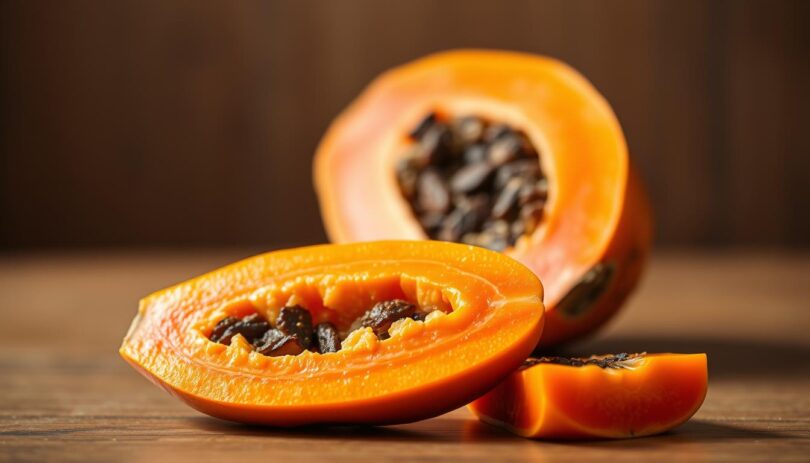As a pet owner, you’re probably always on the lookout for healthy, safe treats to share with your furry friend. Papaya, a vibrant tropical fruit, has gained popularity as a potential snack for dogs. But can dogs eat papaya? The answer is yes, but with some important guidelines to keep your pup safe and healthy.
Papaya is packed with natural nutrients like fiber, vitamins A and E, and digestive enzymes such as papain. These benefits make it a great option for supporting your dog’s digestion and overall well-being. However, it’s crucial to serve papaya in moderation and properly prepare it by removing the skin and seeds, which can pose risks to your dog’s health.
Veterinary experts recommend feeding papaya in small, controlled amounts to avoid gastrointestinal upset. The sugar content in papaya is lower compared to many other fruits, making it a suitable treat for dogs prone to weight gain. Plus, the enzyme papain can aid in protein digestion, which may be especially beneficial for older dogs.
Before introducing papaya to your dog’s diet, it’s important to consult with your vet to ensure it aligns with their specific needs. Stay tuned as we dive into the nutritional benefits, safe preparation methods, and expert tips for incorporating papaya into your dog’s diet.
Introduction to Papaya as a Nutritious Treat for Dogs
Pet owners are increasingly exploring whole, natural fruits like papaya to supplement their dogs’ diets. This vibrant tropical fruit offers a unique blend of bioavailable nutrients that set it apart from traditional dog foods.
Why Consider Adding Papaya to Your Dog’s Diet
Papaya is a nutrient-rich option, offering vitamins, fiber, and enzymes like papain, which supports digestion. Its bright color signifies a wealth of antioxidants that can enhance your dog’s immune system and overall health.
While introducing papaya to your dog’s diet, moderation is key. Start with small amounts to monitor for any adverse reactions. Always remove the skin and seeds, as they pose health risks. Consult your vet to ensure papaya aligns with your dog’s specific needs.
Nutritional Benefits of Papaya for Dogs
Papaya is more than just a tasty fruit; it’s packed with nutrients that can support your dog’s health. Rich in vitamins, minerals, and fiber, papaya offers a natural way to boost your pup’s well-being.
Key Vitamins, Minerals, and Fiber
Papaya is a great source of vitamins A, C, E, and K. It also contains essential minerals like potassium, calcium, and magnesium. The high fiber content helps regulate bowel movements and supports a healthy gut.
Digestive Enzymes and the Role of Papain
The enzyme papain in papaya aids in protein digestion, similar to how it works in humans. This makes papaya a helpful addition for dogs, especially older ones, who may need extra digestive support.
While dogs can make their own vitamin C, papaya’s other vitamins, like A and E, still provide significant benefits. The antioxidants in papaya help protect against free radicals, supporting your dog’s immune system and overall health.
Remember, moderation is key. Papaya should only make up a small part of your dog’s diet. For more trusted nutrition advice, visit Science Diet to explore balanced feeding options.
How to Safely Prepare and Serve Papaya
Preparing papaya for your dog requires careful attention to detail to ensure it’s safe and healthy. Start by washing the fruit thoroughly under clean water to remove any dirt or bacteria.
Proper Preparation: Removing Skin, Seeds, and Portions
Begin by peeling the papaya with a vegetable peeler or a sharp knife, making sure to remove all traces of the skin. Next, cut the papaya in half and scoop out the seeds using a spoon, as they can be harmful to your dog. Once the skin and seeds are removed, cut the papaya into small, bite-sized pieces to prevent choking hazards and make digestion easier.
Guidelines for Safe Serving Sizes
The serving size depends on your dog’s weight. For small dogs (under 30 pounds), start with 1-2 small pieces. Medium-sized dogs (30-50 pounds) can have 3-5 pieces, while larger dogs (over 50 pounds) can enjoy 5-7 pieces. Remember to introduce papaya gradually and monitor your dog’s reaction. Always consult your vet before making any changes to your dog’s diet.
For more information on safely introducing new foods, visit this resource to ensure your pet’s health and well-being.
can dogs eat papaya? A Detailed How-To Guide
Introducing new foods to your dog’s diet can be exciting yet nerve-wracking. Papaya, with its vibrant color and nutritional benefits, is a great option, but it requires careful handling to ensure your dog’s safety and enjoyment.
Identifying Safe Portions and Introduction Techniques
Start by consulting your veterinarian to discuss your dog’s specific needs and health status. When introducing papaya, begin with small amounts to monitor for any adverse reactions, such as digestive upset or allergic responses.
The serving size varies based on your dog’s weight. For small dogs, 1-2 pieces are sufficient, while larger dogs can have up to 7-8 pieces. Always remove the skin and seeds to avoid potential health risks.
Papaya should be an occasional treat, not a daily staple. Mix it with their regular meals to ease the transition. Remember, moderation is key to maintaining your dog’s balanced diet and overall well-being.
Complementary Fruits and Balancing Your Dog’s Diet
While papaya is a nutritious treat, diversifying your dog’s fruit intake can provide a broader range of nutrients. Introducing other dog-safe fruits can enhance their diet and overall health.
Other Dog-Safe Fruits to Consider
Bananas are a great source of potassium and fiber, making them a wholesome snack. Blueberries, rich in antioxidants, support cognitive health and are easy to serve as a tasty treat. Mangoes offer vitamins A and C, while watermelon provides hydration with its high water content.
It’s important to avoid harmful fruits like grapes and raisins, as they can cause serious health issues. Always remove seeds and pits from fruits like peaches and apricots to prevent choking hazards or toxicity.
Mixing small portions of these fruits with papaya creates a balanced and nutritious treat. Remember, fruits should only make up a small part of your dog’s diet. Always introduce new fruits gradually and consult your vet to ensure the best dietary choices for your pet.
Expert Vet Advice and Practical Feeding Tips
When considering new foods for your dog, it’s essential to approach with care and expert guidance. Veterinarians recommend starting with small portions to assess your dog’s tolerance and digestive response.
When to Introduce New Foods like Papaya
Vets suggest introducing papaya gradually. Begin with a tiny amount and observe your dog’s reaction for at least 24 hours. This helps identify any signs of discomfort or allergic reactions.
Monitoring Your Dog’s Reaction and Overall Health
Watch for symptoms like vomiting, diarrhea, or skin irritation. If you notice any unusual behavior, consult your vet immediately. Regular check-ups ensure your dog remains healthy and thrives with new additions to their diet.
Practical tips include balancing treats with regular meals to maintain nutrient balance. For example, mix a few pieces of papaya with your dog’s usual food. This approach supports a varied diet without overloading on treats.
Remember, every dog is different. Factors like age, weight, and health conditions influence how your dog reacts to new foods. Always prioritize your dog’s health and consult professionals for personalized advice.
Final Reflections on Adding Papaya to Your Dog’s Diet
Incorporating papaya into your dog’s diet can be a rewarding experience when done thoughtfully. This fruit offers benefits like improved digestion and a nutrient-rich profile, making it a great addition to your dog’s meals. However, remember to prepare it safely by removing the skin and seeds, and serve it in appropriate portions based on your dog’s size.
Veterinarians suggest introducing papaya gradually to monitor your dog’s reaction. Start with small amounts and watch for any signs of discomfort. It’s important to balance papaya with other healthy foods to ensure a well-rounded diet. For more guidance on safely introducing new foods, visit this resource.
With careful planning and attention to your dog’s needs, papaya can be a nutritious and enjoyable treat. Always prioritize your dog’s health and consult with experts for personalized advice. By making informed choices, you can enhance your dog’s quality of life and overall well-being.
FAQ
Is it safe for my dog to eat papaya?
Yes, papaya can be a safe and healthy treat for dogs when served in moderation. It offers vitamins, fiber, and antioxidants that support your dog’s health. However, always remove the skin and seeds before serving to avoid any potential risks.
What are the health benefits of papaya for my dog?
Papaya is rich in vitamin C, vitamin A, and dietary fiber, which can aid digestion. The enzyme papain in papaya helps break down proteins, supporting a healthy digestive system and immune function in dogs.
How should I prepare papaya for my dog?
Always wash the papaya thoroughly. Remove the skin and seeds, as they can cause digestive issues. Cut the fruit into small, manageable pieces to prevent choking and ensure safe consumption.
What is the recommended serving size for papaya?
Serve papaya in small amounts, as an occasional treat. A few small pieces or a teaspoon of papaya per 10 pounds of your dog’s weight is a good guideline. Overfeeding can lead to an upset stomach due to the fruit’s sugar content.










Leave a Comment